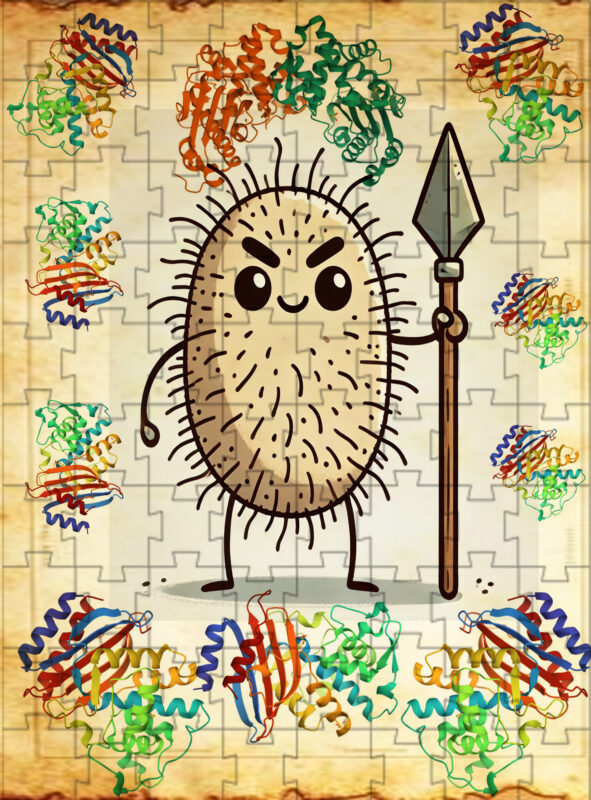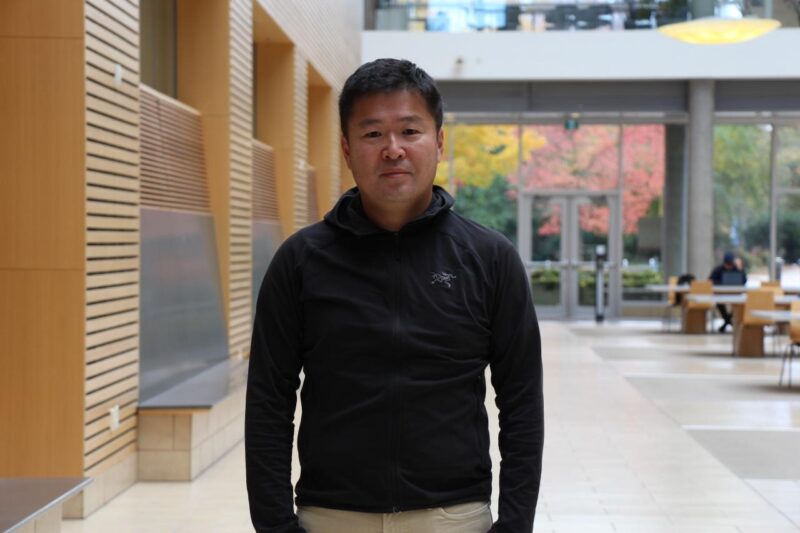Newsroom
Dr. Tokuriki’s Path in Science: Exploring the Evolution of Antibiotic Resistance
Writing and figure by Santanu Sasidharan from the Tokuriki Lab, Michael Smith Laboratories

Bacteria wield a diverse set of enzymes as weapons against antibiotics. (A portion of this figure was AI-generated.)
From towering white pines to the tiniest microbes, all life forms on Earth share a common thread: evolution. This powerful process has shaped all living beings on earth, yet many of its mysteries remain unsolved. We do know, though, that while evolution often feels like a grand, ancient process, it is constantly happening all around us, even right now as you read.
Dr. Nobuhiko Tokuriki (MSL, Biochemistry and Molecular Biology) is a scientist who isn’t just studying evolution, but wants to watch it unfold at the molecular level in proteins. Proteins are more than just a buzzword when it comes to hitting the gym and nutrition, they are the building blocks of life itself. As it turns out, they also hold the key to one of the most critical medical challenges of our time: antibiotic resistance. As deadly resistant bacteria continue to evolve and outsmart us, the stakes are getting higher and higher. Dr. Tokuriki’s work has evolved alongside this challenge, as he now looks to understand how these tiny microbes adapt, mutate and evolve in different ways to survive the ongoing antibiotic war. We spoke with Dr. Tokuriki to explore why he’s interested in this field, and to learn more about the evolution of his own scientific journey.
Did you always know you wanted to pursue a career in science?
My dad was a scientist and researcher, and my grandfather was a professor, so I was familiar with academic life from an early age. Even though I didn’t want to passively follow it, I was drawn to something active and creative. That’s why science appealed to me, and it felt like a field where I could be both engaged and inventive.
Can you briefly describe your scientific journey, from beginning your studies in Japan through your postdoctoral fellowships, to your position as a Professor at UBC?
I completed my Ph.D at the University of Osaka in Japan, where I studied protein evolution with a focus on biophysics. Following that, I spent about five years at the Weizmann Institute in Israel as a postdoctoral fellow with Professor Dan Tawfik (Danny). I then undertook a second postdoc at the University of Cambridge for a year and a half with Professor Florian Hollfelder, where I concentrated more on directed evolution. Following this, I moved to the University of British Columbia as an Assistant Professor. Over time, my research has evolved from biophysics and protein evolution to a more bioinformatics-focused approach, which has expanded into microbiology and antibiotic resistance genes, along with associated pathways. I’ve truly enjoyed how my scientific journey has unfolded.
What inspired you to study protein evolution as a postdoc with Professor Dan Tawfik?
Protein evolution is a very complex and ambiguous area. Any question is valid, but Danny stood out because he had a unique ability to look at the finer details. For example, when people asked general questions like ‘How does evolution work?’ they often got lost in the complexity – mutation, selection, epistasis, and then what? Danny focused on details like specific protein properties and how those influence protein evolution. During my postdoc, we had great discussions about fundamental traits that drive evolutionary change and drew from classic evolutionary theory and applied it there. We spent a lot of time reading old papers and trying to frame specific, impactful questions based on those insights. Danny was intentional in designing research questions rather than just letting them arise passively. He was really something special. I learned a lot from his mentorship style and applied it to my own.
You then moved to England to work with Professor Florian Hollfelder, at Cambridge University, on enzyme evolution and phosphotriesterases. What motivated you to do a second postdoctoral fellowship?
I wanted to become a principal investigator to continue research, but I was not ready after Weizmann to take on administrative responsibilities and managing students. At the same time, I wanted to expand my network, which is why I aimed for a larger university. Weizmann was great, but moving to Cambridge offered a larger academic community with postdocs and students from all over the world. This broader exposure was something I was looking for, and it built my confidence to become a PI. Before this, I wasn’t sure yet if I was good enough.
Taken together, how did your postdoc supervisors influence you as a researcher?
In addition to Danny, there were others who influenced me during my PhD and postdoc; at Cambridge, Dr. Jane Clarke and Dr. Florian Hollfelder were exceptional scientists. All three of them, in different ways, had an impact on me. I tried to learn as much as I could from each of them. I’m especially glad I did a second postdoc, which allowed me to work closely with the researchers at Cambridge and have conversations not just about science, but also about project management and mentoring strategies. It’s hard to pinpoint exactly what I took from each person, but I know I adopted Danny’s approach to supervising students. He was very hands-on and always available, creating a supportive environment.
What about UBC drew you to apply for a tenure track professor position?
As I was finishing up my second postdoc, someone told me about a university position that opened up at UBC. To be honest, I didn’t know much about UBC before applying. I had never been to North America, so my knowledge of universities here was pretty limited. I did know a few people, like Dr. Steve Withers. Still, I was glad that I took the position—the environment and the people here are great.

Dr. Nobuhiko Tokuriki
You are now actively involved in antimicrobial resistance and enzyme research. This is quite different from your earlier training in protein evolution. Can you describe how these two research areas intersect, and what led you down this path?
My core interest has always been protein evolution, and it has been the thread running through all my work. Over time, I began asking myself what impactful topics within protein evolution could be applied to areas like antimicrobial resistance (AMR) and enzyme evolution. That line of thinking led me to focus on how AMR evolution could actually help us better understand protein evolution. It felt like the perfect intersection; an urgent medical challenge and an evolutionary puzzle. Simply put, I am using AMR as a lens to explore the mechanism of protein evolution, while also aiming to contribute to medically relevant research.
How has your research made an impact in the field, and where is the field moving next?
That’s a really interesting question and honestly, a bit of a tricky one. AMR is such a broad and urgent field. While there are researchers focussed specifically on the evolution of resistance, it is still unclear how much of the evolutionary perspective can be integrated into mainstream AMR research. There is definitely a niche community interested in broader evolutionary principles and how they apply to resistance, but this is not yet the mainstream approach. My work sits more at the intersection. I focus on protein evolution and explore how resistance evolves, but I am not directly involved in the clinical applications. While we hope that our findings offer a foundation for the AMR community, it is up to the experts in that space to pick it up and run with it.
At the end of the day, applying evolutionary research to real-world medical decisions is complex. The potential impact of our work is there, but how widely is it being used? That’s still an open question.
How have you found Canada as a place to carry out research? What do you enjoy the most about living in Vancouver?
There are both benefits and challenges. Canada is a great country that supports science, and there are many outstanding researchers here, especially at UBC. We are also close to the U.S., which has one of the largest scientific communities in the world, so access to people and ideas is relatively easy. At the same time, being separate from the U.S. gives Canada a unique identity, especially in terms of funding, as we’re not competing directly with our American counterparts for the same resources.
Canada’s vast geography and relatively small population can make in-person communication and collaboration more challenging. Unlike Japan or Europe, where higher population densities promote more concentrated scientific communities, Canada’s research landscape can sometimes feel more dispersed. However, this environment has cultivated a spirit of resilience and creativity, empowering us to build strong, diverse networks and forge meaningful connections across distances.
What advice would you provide to graduate students and postdocs who are still on their own journeys?
‘Change’. Change is important to grow and experience new things. It’s valuable to live in different places and expose yourself to different cultures. For example, if you grew up in North America, I’d recommend spending time in Europe. It’s important to keep adapting and learning from your environment.
When you’re young, moving to a new country can be eye-opening, but it’s not always easy. Being in a foreign place can force you to confront and adapt to challenges. Science also varies significantly depending on the country, funding, culture, and people. All these influences how science is done, and that shapes scientific thinking in different ways. From my perspective, experiencing science in different places is crucial.
Dr. Tokuriki’s journey reveals a scientist shaped as much by experience as by inquiry. What stood out most in this conversation wasn’t just his scientific insight, but the depth of reflection on the journey that brought him here. His story is one of curiosity shaped by movement across countries, cultures, and ways of thinking. While science provided the framework, it was the people, places, and challenges along the way that truly influenced his path. His openness to change, even when uncomfortable, and his belief in learning from every environment reveal a scientist who sees beyond data: a thinker shaped not just by what he studies, but by how and where he lives. It’s a reminder that science, at its core, is a deeply human pursuit.